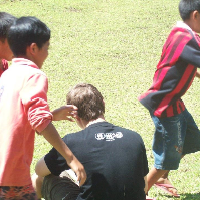import greenfoot.*; // (World, Actor, GreenfootImage, Greenfoot and MouseInfo)
/**
* The ball of the game. It moves and bounces off the walls.
*
* @author mik
* @version 1.0
*/
public class Ball extends Actor
{
private int deltaX; // x movement speed
private int deltaY; // y movement speed
private int count = 2;
/**
* Create a ball with random movement.
*/
public Ball()
{
deltaX = Greenfoot.getRandomNumber(11) - 5;
deltaY = Greenfoot.getRandomNumber(11) - 5;
}
/**
* Act. Move and produce smoke.
*/
public void act()
{
makeSmoke();
move();
}
/**
* Move the ball. Then check whether we've hit a wall.
*/
public void move()
{
setLocation (getX() + deltaX, getY() + deltaY);
checkWalls();
}
/**
* Check whether we've hit one of the walls. Reverse direction if necessary.
*/
private void checkWalls()
{
if (getX() == 0 || getX() == getWorld().getWidth()-1) {
deltaX = -deltaX;
}
if (getY() == 0 || getY() == getWorld().getHeight()-1) {
deltaY = -deltaY;
}
}
/**
* Put out a puff of smoke (only on every second call).
*/
private void makeSmoke()
{
count--;
if (count == 0) {
getWorld().addObject ( new Smoke(), getX(), getY());
count = 2;
}
}
}





